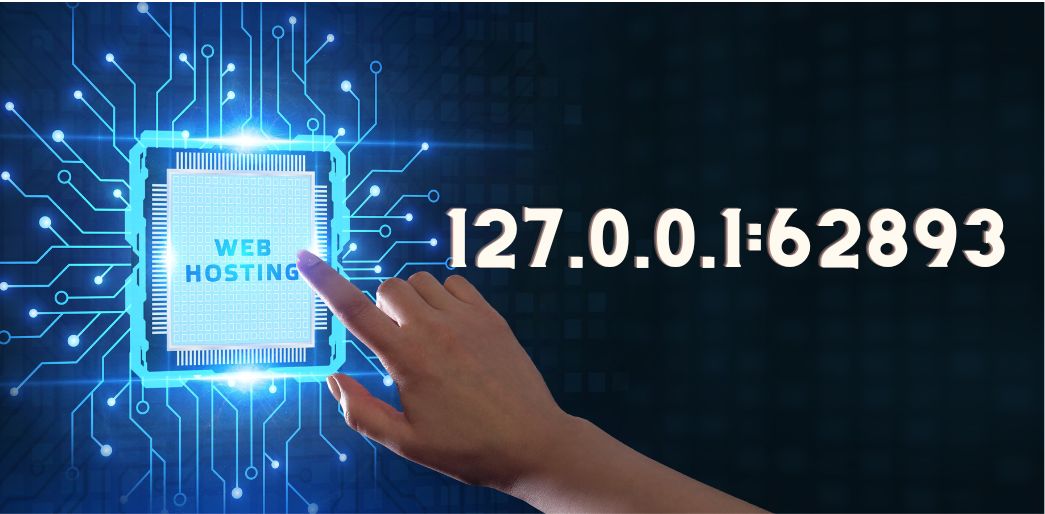Introduction to 127.0.0.1:62893
In the vast world of networking, some numbers hold a special significance. Among them is 127.0.0.1:62893—a combination that might seem technical but plays a crucial role in your local network security. ALSO READ: 127.0.0.1:49342
Imagine this IP address as your digital fortress, safeguarding your connections and applications from external threats while allowing you to experiment freely within your environment. Understanding its function can empower developers, system administrators, and tech enthusiasts.
As we delve into the fascinating realm of local host addresses and dynamic ports, we’ll uncover how 127.0.0.1:62893 enhances security measures and fosters safe development practices right at home or in an office setting.
So, let’s explore what makes this particular configuration so vital for anyone looking to bolster their cybersecurity defences while navigating the ever-evolving technology landscape!
Understanding 127.0.0.1: The Localhost Address

The localhost address, 127.0.0.1, bridges your device and the digital world within its confines.
This IP address is often called the loopback address. It creates a direct pathway for data communication on the same machine without hitting external networks. It’s like an internal postal service—it delivers messages directly home.
When you enter 127.0.0.1 in your browser, you’re telling it to look inward rather than outward into cyberspace.
This capability makes it crucial for developers and network engineers who need a safe environment for testing applications or configurations before releasing them into broader contexts.
They are using Usersun servers locally, and using this unique address keeps their work isolated from potential online threats or vulnerabilities on public networks.
What is 127.0.0.1?

The IP address 127.0.0.1 is univerrecognized as the localhost or loopback address in networking. It serves a cruallowsto communicate with itself.
When applications need to send data, they often direct it to this specific address instead of using an external network route. This internal communication helps developers test various services without exposing them externally.
As part of the larger IPv4 standard, 127.0.0.1 commands significant importaImportancecurity and functionalitImportanceocal environments.
This address ensures that any traffic sent does not leave your machine, protecting sensitive data from potential interception during development or testing stages.
It’s a vital tool for debugging and refining software before deployment into more public spaces where vulnerabilities could arise.
The Significance of Loopback Addresses

Loopback addresses hold a specialsspecial They provide a means for devices to communicate with themselves, creating an isolated environment for testing and troubleshooting.
The recognized loopback address is 127.0.0.1, commonly known as” This unique IP allows developers to validate applications without risking exposure to external networks.
Using loopback addresses enhances security by containing traffic within the local machine. External threats are effectively kept at bay during development and debugging processes.
Moreover, these addresses simplify network configurations. They eliminate the need for actual hardware while allowing seamless interaction between software components on the same device.
For anyone working in IT or software development, understanding the significance of loopback addresses is essential for building robust systems that prioritprioritisingd efficiency.
The Role of Ports in Networking
Ports play a crucial role in networking by facilitating communication between devices. They act as endpoints for data transmission, allowing multiple applications to use the same IP address without conflict.
Each port is identified by a unique number ranging from 0 to 65535. This numbering system enables different services and protocols to operate simultaneously on a single machine.
Well-known ports are often associated with specific protocols; for example, HTTP typically uses port 80 while HTTPS,, operates on port 443. However, dynamic or ephemeral ports can be allocated as needed for temporary connections.
This flexibility helps enhance network efficiency and security. By directing traffic through designated ports, systems can better manage data flow while reducing vulnerabilities linked to open connections. Understanding and understanding how functions are performed is essential for effective network management and protection against potential threats.
What are Ports?
Ports are essential components in networking, serving as communication endpoints for various services and applications. They allow multiple programs to use the same network connection without interference.
Each port is identified by a unique number that ranges from 0 to 65535. This range is divided into caorts, registered, and dynamic or private ports. Well-known ports (0-1023) host widely used services like HTTP or FTP.
When your device connects to the internet or any local networutilizesilizes specific ports for data transmission. These connections can be established through TCP (ssion Control Protocol) or UDP (User Datagram Protocol), each catering to different date requirements.
In essence, UUnderstandingunction helps reinforce security measureoptimizetimize application performance on networks.
Dynamic Ports Explained
Dynamic ports, often referred to calledorts, play a crucial role in network communications. Unlike static ports that remain, whichd for specific services, dynamic ports are assigned on-the-fly bon the flyating system.
When an application requests a connection, it can use these temporary ports to establish communication with servers or other devices. This flexibility allows multiple applications to run simultaneously without port conflicts.
Typically raDynamic ports, typicallym 49152 to 65535, dynamic portresources efficiently. They ensure that each se has its unique eint minimizingmizing the riunauthorizedorized access.
This dynamic allocation is particularlybeneficialents where numerowith frequent connectionsowsing or file transfers. By leveraging these transient addresses, systems maintain optimal performance and security during interactions over local networks and beyond.
The Importance of 127.0.0.1:62893 in Local NetwImportancece
The address 127.0.0.1:62893 plays a crucial role in enhancing local network security. It provides a haven fplications to communicate without exposure to external threats.
By isolating services on this loopback address, developers can ensure that sensitive data does not travel over public networks. This containment is vital for protecting information during the development and testing phases.
Additionally, using port 62893 allows customization of application behavior specifically for secure environments. Developers can tweak settings and configurations that suit their security protocols without impacting the broader network.
ComprehensiveThis setup makes comprehensive monitoring possible. Administrators can log activities efficiently and detect anomalies promptly. Such vigilance helps identify vulnerabilities before they are exploited.
Firewall configurations gain strengthutilizinglizing 127.0.0.1:62893 as well, alighter controls on incoming and outgoing traffic within the local environment while reinforcing overall security measures against cyber threats.
1. Isolation from External Threats
Using 127.0.0.1:62893 creates a protective barrier against external threats. This local address ensures that all traffic remains within the confines of your machine, preventing unwanted access from outside networks.
Because data transmitted through this port does not leave your device, it significantly reduces the risk of interception or exploitation by malicious actors. Hackers often target exposed IP addresses; however, localhost effectneutralizesalizes this vulnerability.
Essentially, isolation promotes a safer environment for sensitive operations and applications. Developers can work on projects without worrying about potential breaches during testing phases.
Moreover, any service running on 127.0.0.1:62893 is shielded from remote attacks—an invaluable asset in today’s increasingly hostile cyber landscape, where every layerr of security counts.
2. Secure Development and Testing Environment
Creating a secure development and testing environment is essential for any software project. When using 127.0.0.1:62893, developers isolate their applications from the outside world.
This isolminimizesimizes exposure to potential vulnerabilities during development phases. It allows teams to experiment without risking external interference or attacks.
Testing applications locally on this address means that sensitive data remains protected from prying eyes. Developers can safely execute code changes, knowing they won’t inadvewon’tly expose security flaws.
Moreover, debugging tools and logs are more effective in a controlled setting like this. It enables easier identification of issues before deploying to production environments.
With each test run confined within the localhost, ylocal hostte reliability while ensuring your application’application’stands strong against emerging threatCustomizationzation of Application BehCustomizationzation of application behavior is behaviourrul featureutilizinglizing 127.0.0.1:62893 within local networks. Developers can tweak their applications to suit specific needs without worrying about external influences.
By using thiAAdjustments in real time, allowing f using this loopback address using this loopback addressor rapid testing and iteration. This flexibility encourages innovation as developers experiment with different configurations or features.
Moreover, isolating the application from the broader network ensures that any unintendide effects remain contained. It’s an exceIt’sIt’st environment for debugging and refining functionalities before deployment.
customizationzation isn’t just limited to performance tweaks; security settings can also be tailored specifically for each use case. Enhanced control leads to better resource management and user experience in the development stages, producing more robust products for public release.
4. Comprehensive Monitoring and Logging
Comprehensive monitoring and logging are vital to utilizing27.0.0.1:62893 in local network security. By keeping a monitoring list, developers can detect problems early.
Logging captures every request and response that flows through this local host. The localhost’s transparency ensures that unauthorized access attempts or unusual behavior are detected.
Monitoring tools enhance the ability to track performance metrics. They provide insight into application health, revealing potential issues before they escalate.
Moreover, detailed logs are a flare tool during investigations following an incident. Analyzing past events helps refine security measures for the future.
Incorporating comprehensive monitoring establishes a robust defense mechdefencegainst threats whilemechanism against62893 for various applications and services.
5. Enhanced Firewall Configurations
Enhanced firewall configurations play a crucial role in securing the local network landscaputilizinglizing 127.0.0.1:62893, developers can create strict rules that limit access to only trusted applications and services.
This minimizes the risk of unauthorized users breaching sensitive data through the localhost. Local firewalls can be finely tuned to allow traffic solely from specific ports or protocols, enhancing overall security.
Moreover, incorporating application-specific rules enables better monitoring of incoming and outgoing traffic associated with 127.0.0.1:62893. This provides additional protection against potential threats while ensuring legitimate communications are uninterrupted.
Frequent updates to these configurations keep pace with emerging vulnerabilities, allowing for proactive defense mechanisms tailored for local environments. With such measures, onions can maintain Tirol over their internal networks without compromising functionality.
6. Secure Remote Access Solutions
Secure remote access solutions play a vitalare vitalng 127.0.0.1:628vitalnrolesin ecurityutilizinglizing this local address, developers can create secure tunnels for data transmission.minimizesimizes exposure to external threats while maintaining robust functionality.
Software such as VPNs and SSH can be configured to route through localhost colocal-hostt. This ensures that sensitive information is encrypted during transit.
Moreover, the Lo interface allowLousers to test remote access setups without risking their network connectionnetwork connectionst way tthe besty vulnerabilitiesvulnerabilities
Incorporating these solutions helps maintain control over who accesses critical resources from outside networks, giving businesses peace of mind in protecting their infrastructure.
7. Adaptation to Emerging Security Threats
The digital landscape is ever-changing, with new vulnerabilities emerging constantly. Localhost addresses like 127.0.0.1:62893 provide a crucial buffer against these evolving threats.
As cybercriminals refine their tactics, it becomes essential for developers and network administrators to adapt promptly. The use of tUsingss allows for immediate updates Usinghout exposing the broader network.
By leveraging localhost environments, teams can simulate attacks in controlled settings. This proactive approach helps identify weaknesses before they become significant issues.
Moreover, employing advanced security protocols within these local frameworks ensures that responsible and effective threats are appropriately adapted and addressed, maintaining robustness against sophisticated intrusions that target both application and data integrity.
Embracing chanapplicationecurity practices fosters resilience against an unpredictable threat landscape while protecting valuable resources effectively.
Practical Applications of 127.0.0.1:62893
The address 127.0.0.1:62893 serves as a powerful tool in various practical applications.
In application development, developers utilizetilize this loopback IP to create and test software without the fear of fearinglnerfearing vulnerabilitiesterations and debugging in a controlled setting.
Regarding base connections, using 127.0.0.1:62 ensures that sensitive data remains confined within local environments, safeguarding against potential breaches.
Local web servers benefit from this address; they can run, too; theyial for maintaining s efficiently while accessing themafe testing grounds for new features before public deployment.
Furthermore, many services rely on this port configuration to maintain seamless communication between different components of an application stack without exposing them to outside threats or interferences.
Application Development and Testing
Application development and testing thrive on the localhost address 127.0.0.1:62893. This unique setup allows developers to create a safe space for building applications without exposing them to external risks.
Using thiUsingaddress, you can test funUsings in real-time whreal timeng sensitive data secure from pwhileatimingats. Developers is appis reciate the ability to simulate various scenarios locally before pushing code live.
Moreover, having a dedicated port like 62893 enables multiple applications to run concurrently without interference. This flexibility is crucial during the debugginase when pting issues requires immthadebugging when posting issues requires that the back needed be providedtes collaboration among teams working on different components oproject componentsthing containprojectcomponents thinggwork, integration becomes seamless and efficient, ultimately enhancing product quality before depbeforeecure Databasebeforeions
Secure database connections are essential for protecting sensitive information. When developDevelopers use 127.0.0.1:62893 tofe tunnel between their applications and databaUtilizinglizing localhost ensures that data tr within the local macminimizingmizing exposure to external threats. This isolation significantly reduces the risk of interception by malicious actors.
Encryption protocols like SSL/TLS can be implemented easily in this setup, adding an extra layer of security during data transmission. With encrypted connections, even if someone gains access to the network traffic, deciphering the data becomes nearly impossible.
Additionally, using 127.0.0.1:62893 allows developecustomizetomize authentication methods tailored for specific applications or environments without affecting broader network configurations.
This flexibility fosters robust security practices while promoting innovation in application development and testing scenarios.
Local Web Servers and Services
Local web servers and services play a crucial role in the development process. They allow developers to test applications in a controlled environment before deployment, minimizing the risks associated with live environments.
Using 127.0.0.1:62893, developers can set up local quickand eefficient ervers quickly and. This is an isolated space for experimentation without external interference or security threats.
This setup is invaluable for running custom scripts, testing APIs, or creating dynamic websites. Developers can simulate user interactions seamlessly while ensuring data integrity.
Moreover, local servers support various technologies like PHP, N, such ass, or Python frameworks. These versatile options empower teams to choose the best tools for their projects.
Custom configurations on localhost enable tailored setups that closely reflect production conditions—Thisliability—from a development phase to live releases across networks.
Challenges and Considerations
While 127.0.0.1:62893 offers numerous security benefits, challenges remain.
Security misconfigurations can lead to vulnerabilities, exposing local applications to risks. Developers must be cautious and diligent in their setups.
Another concern is the heavy reliance on local security measures. If these safeguards are inadequate or overlooked, threats can infiltrate the system unnoticed.
Additionally, developers should be aware of dependency issues that may ariocalhost for testing environments. An application running seamlessly at this address might not perform identically in a live environment.
Moreover, maintaining consistency across different systems complicates matters further. Differences in configurations could yield unexpected behavibehaviourhaviouroyment.
Users often overlook updates and patches for software tied to 127.0.0.1:62893 addresses—an oversight that can prove detrimental over time as new vulnerabilities emerge.
Security Misconfigurations
Security misconfigurations are a prevalent issue that can expose systems to vulnerabilities. They often involve defaultttings or overlooked updates in software and applications.
These missteps can create openings for attackers. A simple oversight, like leaving unnecessary services enabled or failing to change default passwords, can lead to significant signifiantsignificanthsignificantficantMoreover, the complexity of modern networks makes it easy for configurations to drift over time. Regular audits and reviews are essential to ensure that security measures remain effective.
Developers must adopt a mindset of vigilance. Proper documentation and adherence to best practices can help mitigate these risks significantly.
Training teams on potential pitfalls assists in preventing such issues before they escalate into sthrprioritizingtizing severesecurity during development fosters a robust environment against attacks stemming from misconfigured systems.
Dependency on Local Security Measures
Dependency on local security measures can be a double-edged sword. On one hand, On tthe other handde the fihand,ne of defense agaiddefencetagainst aggravatedotential threats. When using 127.0.0.1:62893, developers often rely heavily on these safeguards for testing applications in isolated environments.
However, this dependency can lead to complacency. Many assume that because theiexternal threats are non-existent r work is confined to localhost, elocal hostset creates vulnerabilities that could be exploited if not addressed prappropriately addressed reliance on local security solutions may overlook broader network considerations. A breach at another point in the system can still compromise data even when local settings seem secure.
It’s essential to train awareness of external risks while strengthening internal protocols. Regular audits and updates should remain a priority for autilizinglizing 127.0.0.1:62893 as part of their workflow or development processes.
Future Implications for Local Network Security
The future of local network security is poised for significant transformation. As cyber threats evolve, there’s an emphasis on securing internal environments like never before. Organizations are beginning to understand the importance of robust defences at the local hoReliance onlianceon 127.0.0.1:62893. Similar will likely grow, allowImportancepers to create secure applications without exposing them externally.
Moreover, as remote work becomes more common, local services must adapt quickly to maintain protection against intrusions. This adaptability includes implementing advanced authentication protocols and encryption techniques that safeguard data even within a trusted perimeter.
Continuous monitoring toolvitalisebe vitalting vulnerabilities before they can be exploited effectively. By integrating these systems into their operations, businesses stand a better chance of staying ahead in this dynamic landscape where threats constantly lurk around every corner.
Evolving Threat Landscape
The digital landscape is constantly changing. New vulnerabilities emerge as technology advances—attackers, and tackrs tactics, makigmakeucial for security practices to evolve alongside these threats.
Cybercriminals increasingly leverage sophisticated techniques, such elikeelealike learningomatautomate.attacks tools allow them to target weaknesses rapidly and at resultt. resul, and defenses may struggle to keep pace.
Moreover, the rise of remote work has significantly increased the attack surface. Accessing networks from various sources introduces new risks that requirerequiring innovative local network security solutionsons must remain vigilant and proactive. Regular updates and assessments are essential for staying one step ahead of potential breaches or exploits that could compromise sensitive data or systems. Embracing adaptive strategies will be vital for maintaining a robust defence threat landscape.
Increased Adoption of Secure Local Services
The shift toward remote work and digital services has sparked a heightened interest in secure local solutions. Individual organizations are increasingly demanding safeguarding data within the confines of their networks. This demand for local regionality measures is driven by concerns over privacy, data breaches, and regulatory compliance. Secure local services provide an effective layer of defence against all threats while protecting sensitive information.
As more businesses adopt cloud-based applications, there’s a grrealizationzation that not all operations should rely solely on external servers. Local environments can be fortified with enhanced controls tailored to specific needs. Technological innovations have made it less challenging to integrate secure practices into everyday workfOrganizationsationcustomizetomize these tools according to their unique requirements to improve resilience without sacrificing efficiency or user experience.
The Need for Continuous Monitoring and Improvement
Continuous monitoring is essential in today’s fast-paced digital landscape. Threats evolve rapidly, and static security measures can quickly become obsolete.
Regular assessmentsorganizationsations identify vulnerabilities before they are exploited. This proactive appminimizesimizes risks and keeps data secure.
Improvement isn’t just about fixing problems; it’s also about enhancing overall security posture. As new technologies emerge, integrating them into existing frameworks is crucial for staying one step ahead.
Automating certain monispecificcprocesses can streamline efforts. It allows teams to focus on strategic improvements while ensuring no potential threat goes unnoticed.
Training staffers on trancheamaintenance a well-informed work workforce is vitrecognizingnising unusual activities that automated systems might miss.
Adaptability should be part of any security organisation must be ready to adjust protocols based on real-time insights and emerging threats, making continuous improvement not just benbeneficialbeneficialn 127.0.0.1:62893
The significance of 127.0.0.1:62893 in local network security cannot be overstated. This address serves as a crucial for IT professionals alike.
Its isolation from external threats creates a safe space for testing applications, worrying about features such as feature monitocustomizationzation, and enhanced firewall configuempowersmpowerintain robust defences.
As technology evolves, so does the need for adaptable solutions that effectively counter this threat. This threat threatens your local environment and remains resilient against potential vulnerabilities while allowing productive development cycles.
Incorporating 127.0.0.1:62893 into your security protocol and advice not just adv; it’s essential today, where cyber here cyber, risks are ever-present and increasingly sophisticated.
FAQs 127.0.0.1:62893
What is the purpose of 127.0.0.1:62893?
This address is a resistor to your lock machine, allowing developers and system administrators to run applications securely without exposure to external networks.
How does 127.0.0.1 enhance local network security?
I am using this late application from outside threats, creating a safe space for development and testing while maintaining control over the environment.
Can I use any port number with 127.0.0.1?
Yes, youyou can utilizerious port numbers; however, it is essential to choose ports not used by other services to avoid conflicts and ensure proper functionality.
Is it safe to expose certain services via localhost?
While localhost offers some security benefits, exposing sensitive services carries risks if misconfigured or improperly secured.
What kind of applications benefit from using this IP address?
Web servers, databases, and development tools typically leverage 127useor secure communication during application development or testiDoDophases.
Do dynamic ports pose any issues on localhost?
Dynamic ports can simplify connections but may lead to, if not appropriately documented, confusion in tracking which port is not docu. Would I mo, monitor my local network configurations related to this IP?
Regular monitoring is crucial as it helps identify potential vulnerabilities early and ensures that any changes do not compromise your security posture.
UnderstandI understand that 1127.0.0.1 can significantly improve during development cycles.













Delhi Capitals vs Mumbai Indians Match Scorecard: 43rd Match at Delhi, IPL, Apr 27, 2024 - msnmag.co.uk
[…] Read: The Role of 127.0.0.1:62893 in Local Network […]